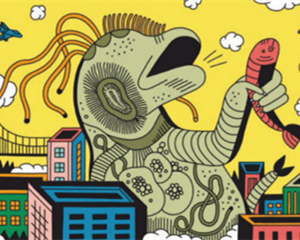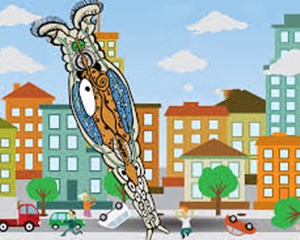- 阅读
- 阅读
- 技巧
- 百科
- 试题
- 文化
- 技能
Aquaculture
水产养殖
Godzilla the rotifer
哥斯拉版轮虫
A mutagenic technique employed for plants is used on animals
一种用于植物的突变技术被用于动物身上
The world's fisheries are overexploited. One way to relieve pressure on them is to increase the yield of fish farms. And one way to do that is to improve the quality of the food fed to the livestock in those farms. Abe Tomoko, of the riken Nishina Centre for Accelerator-Based Science, in Wako, Japan, has a novel proposal for doing this. In her role as director of the centre's beam mutagenesis group, she has overseen the creation of 30 novel cultivars of crops and ornamental plants generated by the selective breeding of promising mutants created using radiation from a particle accelerator called the RI Beam Factory. This time, though, she has applied the technique to animals.
世界渔业被过度开发,能够减轻压力的一个办法是增加养鱼场的产量,其中一种方法就是提高农场牲畜饲料的质量。日本和古市理研西奈加速器科学中心的安倍知子提出了一个新的方案。作为该中心光束突变小组的主任,她监督了30个作物和观赏植物新品种的培育,这些新品种是利用RI光束工厂的粒子加速器辐射产生的有希望的突变体进行选择性育种产生的。不过,这一次,她把这项技术应用到了动物身上。

The young of farm-raised fish species such as yellowtails, halibut, bream and bluefin tuna are fed with live prey. For the smallest fry these are often rotifers, a phylum of tiny animals discovered in the late 17th century by early microscopists. In particular, farmers use a complex of 15 species known collectively as Brachionus plicatilis. The members of this complex are, in turn, divided into three groups classified by size: ss, the adults of which are 170-190 microns long; s, with adults 190-240 microns long; and L, with adults 240-320 microns long. Members of these different groups are fed to progressively larger fish larvae.
养殖的鱼类如黄尾鱼、大比目鱼、鲷鱼和蓝鳍金枪鱼会喂食活的猎物,最小的鱼苗通常会喂食轮虫,轮虫是17世纪晚期由早期显微镜学家发现的一门微小动物。农民们特别使用的是一种由15个物种组成的复合体,统称为褶皱臂尾虫。这个复合体的成员按大小依次分为三组:ss,成虫长度为170-190微米;s,成虫长度为190-240微米;L,成虫长度为240-320微米。这些不同群体的成员会被喂食给逐渐长大的鱼苗。
Above the size of L rotifers, however, farmers switch phylum and feed their charges crustaceans called brine shrimps, the smallest of which clock in at 400 microns. That leaves a size gap which fish do not like. They often develop badly at this stage of their growth, and sometimes resort to cannibalism. Dr Abe and her colleagues therefore wondered, as they describe in Bioscience, Biotechnology & Biochemistry, whether they could plug the gap between the biggest rotifers and the smallest brine shrimps in the way that new plant cultivars are created, by bombarding rotifers with carbon or argon ions spun up to high speed in the beam factory.
然而,L号轮虫再往上,农民们换了门,用一种被称为“盐水虾”的甲壳类动物喂食,最小的盐水虾长度有400微米。这就留下了一个鱼儿们不喜欢的尺寸缺口。在生长的这一阶段它们往往发育不良,有时还会以同类相食。因此安博士和她的同事们就想:正如他们在《生物科学》、《生物技术与生物化学》中描述的那样,他们是否能像培育新的植物品种那样,通过用碳离子或氩离子轰击轮虫使其在光束工厂里高速旋转,以此来填补最大的轮虫和最小的盐水虾之间的空白。
Rotifers are famously asexual. The last time members of one group of the animals, the bdelloids, had sex is reckoned by zoologists to have been about 80m years ago. Members of Brachionus plicatilis are not as sex-starved as that, but they still reproduce for the most part by parthenogenesis. Indeed, the variety Dr Abe chose to work with, known as the Notojima strain, is, like the bdelloids, an obligate parthenogen. For this sort of mutagenic work, however, parthenogenesis is an advantage. It means that a successful mutated line of rotifers will not be diluted by the genetic mixing caused by sexual congress.
轮虫的无性繁殖是出了名的。据动物学家估计,蛭形类动物的最后一次交配发生在大约8000万年前。褶皱臂尾虫的成员并没有那么地“性饥渴”,但它们仍多半通过单性生殖进行繁殖。事实上,安博士选择研究的品种(被称为能登品种)就像蛭形虫一样是专性单性生殖。然而,对于这种突变工作来说,单性生殖是一种优势。这意味着一个成功的轮虫突变系不会被有性繁殖引起的基因混合所稀释。

The Notojima strain is the largest L rotifer used by Japanese fish farmers. In her quest to make it larger still, Dr Abe exposed batches of the animals to ion beams of various strengths and compositions, and then put the survivors through three rounds of proliferation and selection of the largest of their offspring, to try to come up with the Godzillas of the rotifer world.
日本养鱼户使用的最大的L轮虫品种是三岛品种。为了使其更大,阿部博士将几批轮虫暴露在不同强度和组成的离子束当中,然后让存活下来的轮虫进行三轮繁殖并选择其中最大的后代,造出“轮虫界的哥斯拉”。
The upshot, out of more than 3,000 mutant strains that were larger than normal, was three promising lines which, at 350-370 microns long, nicely plug the size gap, and which are also more fecund than their ancestors. Both of these characteristics make the new strains ideal for use as fish food, and three subsequent years of study have shown them to be stable. Godzilla may be fictional. But the idea that radiation, used carefully, can create animals that are giants of their kind, is not.
结果,在超过3000个比正常突变品种大的突变品种中产生了3个有希望的突变系,它们有350-370微米长,正好填补了大小差距,而且比它们的祖先更多产。这两种特性使新品种成为了理想的鱼食,并且随后三年的研究表明它们是稳定的。哥斯拉或许是虚构的,但“辐射(谨慎使用)能创造出同类中的巨型怪”这一观点名副其实。
来源:经济学人
参与评论